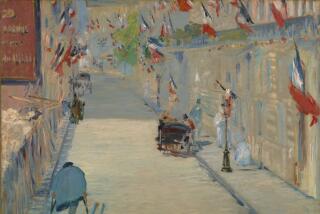Marcel Duchamp’s turning point
- Share via
One hundred years ago today, on March 18, 1912, two men dressed in black crossed the Seine in Paris to pay a call on their younger brother, an artist who lived alone in his studio on Rue Amiral-de-Joinville. Half a century later, the artist would vividly remember the dark clothes his brothers had worn that day, as if they had come to challenge him to a duel.
The visit, it seems, was brief. Once his brothers had departed, the artist locked up the house and took a taxi by himself to the Quai d’Orsay, where the Salon des Independants was scheduled to begin later that week. Upon his arrival, he retrieved a painting that he had entered into the exhibition, carried it out to the taxi and took it home. And in doing so, he changed the course of art history.
The artist was Marcel Duchamp, who was not yet 25. As for the painting, it was an oil on canvas, about 5 feet by 3 feet, or large enough that he would have had some trouble getting it into the taxi. He had painted it two months earlier, as a more fully realized version of a subject that he had attempted the previous year: the abstract image of what seems to be a nude human figure, or a series of outlines of the figure, walking down a flight of stairs.
With its sickly palette of ocher and brown, the picture is not easy to love. There is something robotic or inhuman about the nude, and it’s unclear how much of this quality is intentional and how much is due to the imperfect skills of the artist, who, by his own admission, was a rather mediocre painter. The result tends to make your eyes cross, even before you’ve seen the title, which runs along the lower edge like the caption of a cartoon: “Nu Descendant un Escalier.”
In a way, it was the title that caused all the trouble. At the time, Duchamp was living in the shadow of his two older brothers, both respected artists in Paris. Only a few years earlier, Picasso and Braque had produced the first major works of Cubism, a movement that had been quickly taken up by painters of a more political persuasion, who envisioned it as a socially conscious art form.
It isn’t surprising, then, that they reacted so unfavorably to “Nude Descending a Staircase.” Duchamp’s study of the body in motion smacked of the rival Futurists, and the title only made matters worse. A serious Cubist didn’t paint nudes, and even if he did, the model wasn’t supposed to get up and walk, let alone go downstairs. The fact that the title was painted on the canvas itself only contributed to their suspicion — perhaps not unfounded — that the artist was making fun of them.
In the end, the hanging committee at the Salon rejected the painting, and Duchamp’s brothers were ordered to break the news. At his studio, they presented him with two options: He could either paint over the title and call it something else, or withdraw it from the show altogether. In response, he took it home. Years later, he would say: “It was a real turning point in my life.... I saw that I would never be much interested in groups after that.”
In interviews, Duchamp tactfully declined to describe his feelings at that moment, but it isn’t hard to imagine how hurt he must have felt. Soon thereafter, he began to assume the solitary existence that would characterize the rest of his career. Working alone, he began moving in a direction that would take him past painting entirely, and he was still exploring these possibilities the following year when he learned, much to his surprise, that he had become famous overnight.
What had happened was this. The year before, a group of Americans had toured the studios of Paris, collecting works for a major show in New York. Among others, they had selected “Nude Descending a Staircase,” which had appeared at two other exhibitions in the meantime without attracting any attention whatsoever. Boxed up and shipped across the Atlantic, it joined 300 other European paintings at the 69th Regiment Armory on Lexington Avenue.
Duchamp didn’t hear that the Armory show had made him an instant celebrity until weeks after it opened. By then, for whatever reason, his painting — with its ridiculous title — had come to symbolize all the tricks that viewers feared were being played on them by modern art. On the last day of the exhibition, 10,000 visitors came to stare. Duchamp was delighted, although he had already begun to move beyond the ideas embodied in what would forever remain his most famous work of art.
And it all began with that taxi ride, which resulted in Duchamp’s lifelong pattern of profoundly influencing the movements around him without ever really being a member. When an exhibition in New York claimed to be open to all entries, he tested it by anonymously submitting a urinal, which was promptly rejected. “Fountain,” with its foreshadowing of conceptual art, is considered by many curators, artists and historians to be the most influential artwork of the 20th century, and Duchamp is arguably its most important artist. If you’ve ever gone into an art gallery and wondered what the hell was going on there, that’s almost certainly due to his influence.
If Duchamp had never climbed into that taxi, his career might have gone in an entirely different direction. He was a genius, yes, but no less impressionable than most artists in their 20s, and it’s quite possible that he would have become a responsible Cubist, a minor painter filling a few lines in a survey course. Instead, he took his painting home. He didn’t know it then, but the taxi was bearing him toward the solitude in which he would spend the rest of his life. Almost by accident, it brought the rest of us into the modern age.
Alec Nevala-Lee is the author of “The Icon Thief,” a suspense novel inspired by the work of Marcel Duchamp. He blogs at https://www.nevalalee.com.
More to Read
A cure for the common opinion
Get thought-provoking perspectives with our weekly newsletter.
You may occasionally receive promotional content from the Los Angeles Times.










